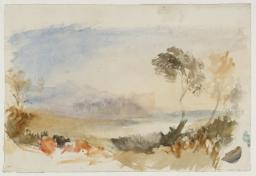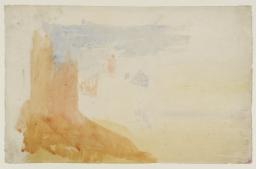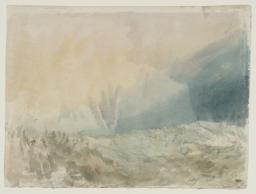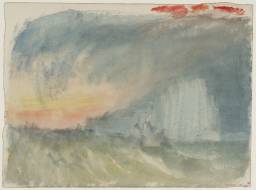Colour Studies Relating to Walter Scott’s ‘Provincial Antiquities and Picturesque Scenery of Scotland’ c.1821–4
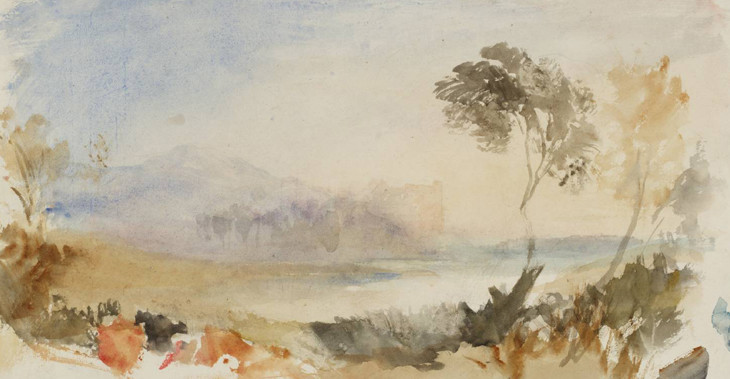
From the entry
Turner was commissioned in 1818 to make watercolours of subjects to be engraved for The Provincial Antiquities and Picturesque Scenery of Scotland by the poet, novelist and antiquarian Sir Walter Scott (1771–1832), published in ten parts between 1819 and 1826 before being issued in bound form in 1826. The four works here are ‘colour beginnings’ directly and indirectly related to two subjects, Linlithgow Palace and The Bass Rock; for a discussion of the function of such preliminary works in general, see the Introduction to the ‘England and Wales Colour Studies c.1825–39’ section. After briefly crossing the border from England in 1797 (see Andrew Wilton’s ‘North of England 1797–1801’ section of this catalogue), Turner first toured Scotland in 1801 (see Wilton’s ‘Scotland 1801–10’), and would do so again in 1818 and 1822 in connection with the Provincial Antiquities ...
References
Turner was commissioned in 1818 to make watercolours of subjects to be engraved for The Provincial Antiquities and Picturesque Scenery of Scotland by the poet, novelist and antiquarian Sir Walter Scott (1771–1832), published in ten parts between 1819 and 1826 before being issued in bound form in 1826.1 The four works here are ‘colour beginnings’ directly and indirectly related to two subjects, Linlithgow Palace and The Bass Rock; for a discussion of the function of such preliminary works in general, see the Introduction to the ‘England and Wales Colour Studies c.1825–39’ section.2
After briefly crossing the border from England in 1797 (see Andrew Wilton’s ‘North of England 1797–1801’ section of this catalogue), Turner first toured Scotland in 1801 (see Wilton’s ‘Scotland 1801–10’), and would do so again in 1818 and 1822 in connection with the Provincial Antiquities project and a royal visit, as fully documented by Thomas Ardill in his ‘Scotland 1818–20’ and ‘George IV’s visit to Edinburgh 1822’ sections. See also Ardill’s ‘Scotland 1831’ and ‘Scotland 1834’ sections, regarding tours to gather material for many later Scott illustrations.3
In all, Turner produced ten landscape and townscape watercolours of Lowland subjects centred on Edinburgh, engraved between 1819 and 1826; now dispersed, most of them were originally owned by Scott.4 There were also vignette frontispieces for the two volumes of the 1826 edition, taken from monochrome designs which subsequently remained in Turner’s studio (Tate D13748, D13749; Turner Bequest CLXVIII A, B);5 they depict episodes from George IV’s 1822 visit and are thus discussed by Ardill in the section mentioned above. Although Turner was the most prominent contributor, seven other Scottish and English artists illustrated a further forty subjects, half of them being by Edward Blore (1787–1879) and John Thomson of Duddingston (1778–1840) who, like Turner, were also shareholders in the project.6
As Katrina Thomson has summarised, in addition to those relating to Linlithgow Palace and the Bass Rock covered here, there are colour studies ‘playing with different effects of atmosphere and light’7 for a third Provincial Antiquities subject, Crichton Castle, in the Scotland and London sketchbook of 1818–19 (Tate D13818; Turner Bequest CLXX 4) and on a page extracted from it (Yale Center for British Art, New Haven).8 The finished watercolour (Morgan Library & Museum, New York)9 was engraved in 1819 (Tate impressions: T04485–T04488, T06056).
For a comprehensive account see Thomson 1999; see also Andrew Wilton, J.M.W. Turner: His Life and Work, Fribourg 1979, and Gerald Finley, ‘Scott, Sir Walter (1771–1832) in Evelyn Joll, Martin Butlin and Luke Herrmann (eds.), The Oxford Companion to J.M.W. Turner, Oxford 2001, p.284.
How to cite
Matthew Imms, ‘Colour Studies Relating to Walter Scott’s ‘Provincial Antiquities and Picturesque Scenery of Scotland’ c.1821–4’, July 2016, in David Blayney Brown (ed.), J.M.W. Turner: Sketchbooks, Drawings and Watercolours, Tate Research Publication, February 2017, https://www

